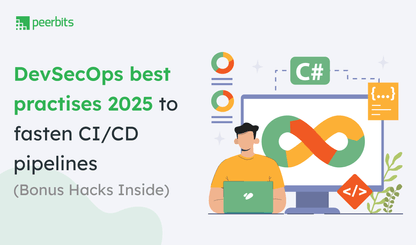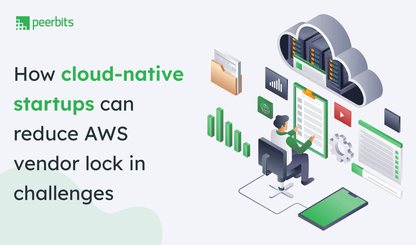Every deployment carries a bit of pressure. A small mistake can ripple across production, frustrate users, and force teams into late-night fixes. That tension isn’t rare. It’s something most software teams face as their systems and user base grow.
Release management brings structure to this chaos, helping teams deploy updates with more control and less risk.
As businesses push for faster and safer delivery cycles, the DevOps market continues to expand. According to Markets and Markets, DevOps market is projected to reach $25.5 billion by 2028. This rise reflects a shift toward mature, well-managed deployment processes across industries.

Release management supports this shift by aligning teams around reliable release planning. It keeps things stable during new launches, bug fixes, and version upgrades. Up ahead, we’ll explore why it matters, the common types of releases, and how to build a process that scales with your team and product.
What is Release Management?
Release Management is a critical process that oversees the planning, coordination, testing, and deployment of software releases from development to production environments.
In other words, it's the process of managing software releases throughout their entire lifecycle, from conception to deployment and ensuring that the releases are delivered efficiently and effectively.
Key components of Release Management
The key components of Release Management include:
- Version control: Version control involves keeping track of different versions of code and software to ensure that developers are working on the correct version of the code.
- Change management: Change management involves tracking and managing changes to software releases, ensuring that changes are made in a controlled and systematic manner.
- Deployment management: Deployment management involves planning and executing the deployment of software releases to production environments
- Release automation: Release automation involves using automated tools and processes to streamline and optimize the software delivery pipeline.
Goals of Release Management in DevOps
The goals of Release Management in DevOps services are focused on reducing risk, increasing efficiency, and enhancing collaboration between development and operations teams.
The primary objective of Release Management is to ensure that software releases are delivered on time, with minimal disruption to operations, and at a high level of quality.
Benefits of Release Management for DevOps
DevOps Release Management offers several benefits for software development and deployment, including:
- Improved reliability and stability of software releases by identifying and fixing bugs, reducing errors, and ensuring consistent performance across different environments.
- Increased collaboration between development and operations teams, enabling faster feedback loops, and better communication and coordination between teams.
- Faster time to market by streamlining the software delivery pipeline, reducing manual processes, and automating testing and deployment.
- Enhanced customer satisfaction by delivering high-quality software releases that meet customer needs and expectations.
- Cost savings and greater efficiency by reducing downtime, minimizing errors, and optimizing resource utilization.
Release Management Types
There are three main types of Release Management:
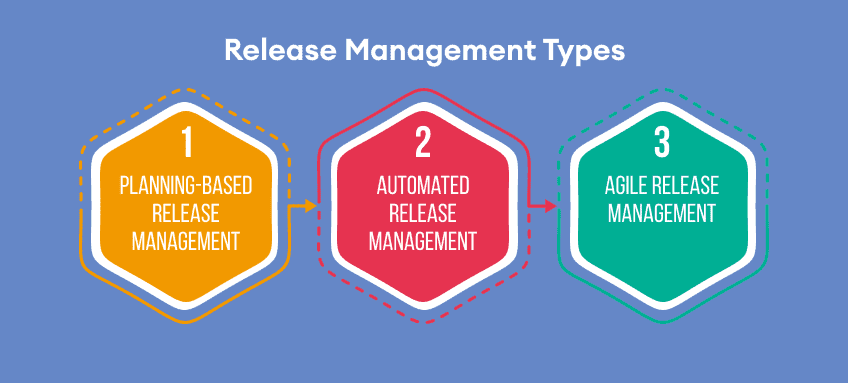
Planning-based Release Management
It involves a structured approach to planning, testing, and deploying software releases. This type of Release Management is suitable for large and complex projects with long release cycles.
Automated Release Management
It involves the use of automated tools and processes to manage the entire software delivery pipeline, from development to deployment. This type of Release Management is ideal for organizations that require frequent and rapid releases.
Read more: Agile Software Development Methods: A Complete Guide
Agile Release Management
It is a flexible and iterative approach to Release Management, focused on delivering incremental changes and continuous improvements to software releases.
This type of Release Management is best suited for organizations that require quick and frequent releases, with the ability to adapt to changing requirements and feedback.
DevOps Release Management Best Practices
Implementing agile methodologies, automation, and continuous integration and delivery to streamline software releases and improve collaboration between development and operations teams.
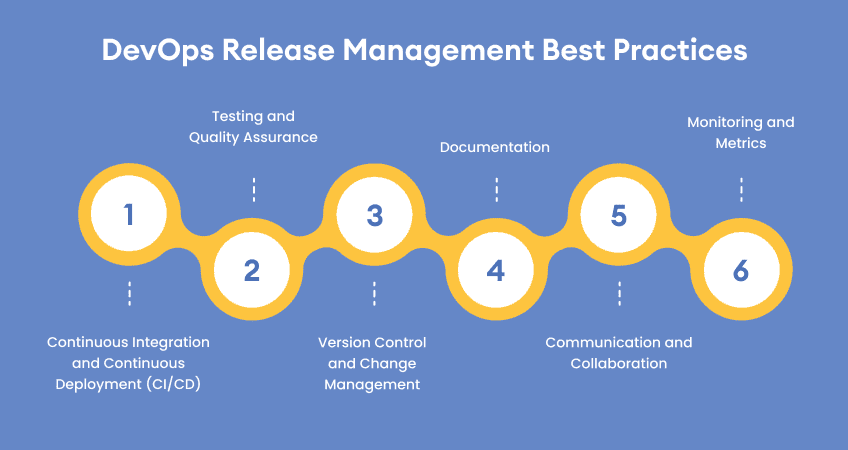
Continuous Integration and Continuous Deployment (CI/CD)
Continuous integration (CI) and continuous deployment (CD) are crucial elements of DevOps release management. They involve automating the software build, test, and deployment process to reduce the time it takes to deliver software updates.
CI/CD ensures that new code is integrated into the existing codebase quickly and efficiently, with minimal disruption to the development cycle. DevOps CI/CD services can help organizations implement CI/CD best practices.
Testing and Quality Assurance
Testing and quality assurance are critical components of DevOps release management. Quality assurance ensures that software releases meet the required quality standards, and testing helps to identify and fix bugs before they reach the end user.
DevOps services and solutions providers can help organizations implement robust testing and quality assurance processes.
Version Control and Change Management
Version control and change management are essential to DevOps release management. They involve managing changes to software code and tracking revisions to ensure that developers are working with the latest version of the code.
Version control also allows developers to collaborate effectively on code changes, reducing the risk of conflicts and errors.
Documentation
Documentation is critical to DevOps release management. It helps to ensure that everyone involved in the software development process has access to up-to-date information and instructions.
Documentation also helps to maintain consistency and clarity across the development process, reducing the risk of errors and miscommunications.
Communication and Collaboration
Effective communication and collaboration are crucial to DevOps release management. It involves ensuring that all team members are aware of their responsibilities and deadlines and that everyone is working towards a common goal.
Communication and collaboration help to reduce the risk of misunderstandings and errors. And ensure that software releases are delivered on time and to the required quality standards.
Monitoring and Metrics
Monitoring and metrics are essential to DevOps release management. They involve tracking the performance of software releases and identifying any issues that arise. It also helps to ensure that software releases meet the required performance standards and enable organizations to identify opportunities for improvement.
Types of Release Management DevOps Tools
Deployment automation tools enable DevOps teams to automate the process of deploying software releases, ensuring consistency and reducing errors. Below are a few of the promising types of release management DevOps tools that top DevOps consulting companies use.
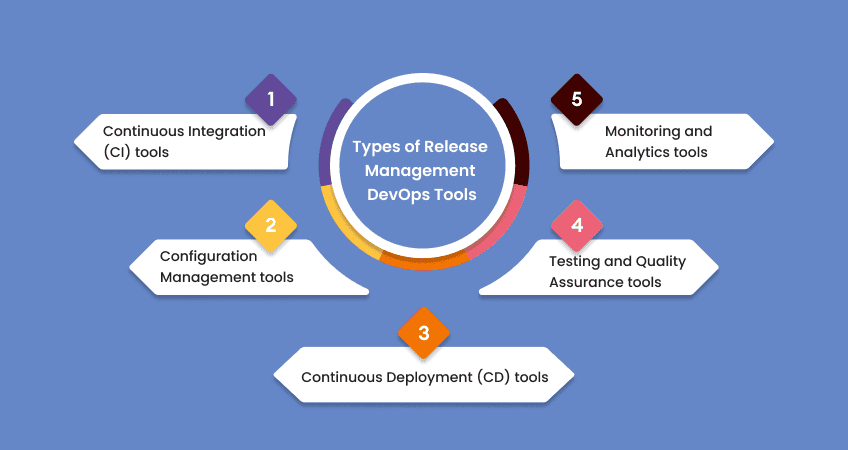
Continuous Integration (CI) tools
Continuous integration tools automate the build, test, and integration of software code. They include tools such as Jenkins, CircleCI, and Travis CI.
Configuration Management tools
Configuration management tools automate the deployment and management of software environments. They include tools such as Puppet, Chef, and Ansible.
Continuous Deployment (CD) tools
Continuous deployment tools automate the release of software code to production environments. They include tools such as Kubernetes, Docker, and AWS CodeDeploy.
Testing and Quality Assurance tools
Testing and quality assurance tools automate the testing and quality assurance process. They include tools such as Selenium, JUnit, and Appium.
Monitoring and Analytics tools
Monitoring and analytics tools track the performance of software releases and identify issues that arise. They include tools such as Nagios, Prometheus, and Splunk.
Release Management Process
Efficiently and effectively deploying software updates to maximize user satisfaction and minimize disruptions. A systematic approach to planning, scheduling, coordinating and deploying software updates and changes.
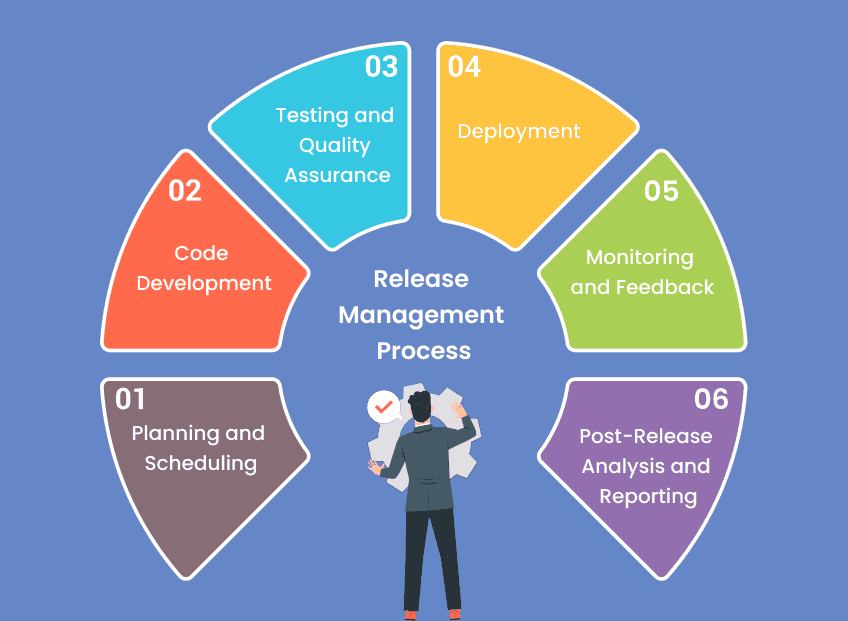
Planning and Scheduling
The release management process begins with planning and scheduling. It involves identifying the scope of the release, setting timelines and deadlines, and allocating resources.
Code Development
Code development involves writing and testing software code. It includes activities such as code reviews, unit testing, and integration testing.
Testing and Quality Assurance
Testing and quality assurance involve ensuring that the software release meets the required quality standards. It includes activities such as functional testing, regression testing, load testing, and user acceptance testing (UAT).
DevOps services and solutions providers can help organizations implement comprehensive testing and quality assurance processes.
Deployment
Deployment involves releasing the software to production environments. Continuous deployment tools automate this process, ensuring that software releases are delivered quickly and efficiently. DevOps consulting services can help organizations implement the most effective deployment strategies.
Monitoring and Feedback
Monitoring and feedback involve tracking the performance of software releases and identifying any issues that arise. Monitoring tools such as Nagios and Prometheus can help organizations track metrics such as response times, error rates, and resource utilization.
Feedback mechanisms such as user surveys and support channels can help organizations identify areas for improvement.
Post-Release Analysis and Reporting
Post-release analysis and reporting involve evaluating the success of the software release and identifying areas for improvement. It includes activities such as;
- Gathering feedback from users
- Analyzing performance metrics
- Documenting lessons learned
Post-release analysis and reporting are crucial to the ongoing improvement of DevOps release management processes.
Role of DevOps in Digital Transformation
Are you wondering what is the role of DevOps in digital transformation? DevOps plays a critical role in digital transformation by facilitating collaboration between development and operations teams. Let us dig more into how it actually does.
How DevOps enables digital transformation
DevOps has become an essential factor in enabling digital transformation in enterprises, by promoting a culture of collaboration, communication, and continuous improvement across teams.
Best DevOps Consulting Companies can help enterprises implement DevOps best practices to achieve faster, more efficient software delivery that meets the needs of customers in a rapidly changing business environment.
DevOps Best Practices for implementing DevOps in an enterprise
To implement DevOps in an enterprise, including software development companies, it is important to follow best practices such as;
- Building a cross-functional team
- Creating a culture of collaboration
- Embracing automation
- Adopting agile methodologies
- Implementing continuous integration and delivery (CI/CD)
These practices help to break down silos, improve communication and collaboration, and promote a continuous feedback loop that fosters innovation and continuous improvement.
Benefits of DevOps for enterprise
Adopting DevOps can provide numerous benefits for an enterprise, including custom software development companies, such as;
- Faster time-to-market
- Improved product quality
- Enhanced collaboration and communication
- Increased efficiency and productivity
- Reduced costs
- Greater customer satisfaction
Conclusion
Release management helps bring structure and predictability to software delivery. It’s not just about shipping code, it’s about building a dependable process that connects planning, development, deployment, and monitoring into a single rhythm. By applying the best practices covered here, teams can reduce deployment risks, deliver updates faster, and maintain stability even as projects scale. A strong release cycle supports better team coordination and leads to more reliable user experiences.
If you’re planning to implement DevOps or improve your release workflows, working with the Best DevOps Consulting Companies can give you the support needed. They can help you adopt automation, streamline deployments, and improve overall delivery speed and quality.
With the right guidance, your team can release confidently, respond faster to changes, and meet user expectations with every update.

FAQ's
In DevOps, release management is more iterative and automated. It emphasizes continuous delivery and integration, reducing manual handoffs and enabling faster, more reliable software releases.
Change management ensures that releases align with business goals and that stakeholders are aware of risks. It provides a governance layer that complements the technical aspects of DevOps.
Absolutely. Even though deployments may be more modular or automated, coordinating updates, managing dependencies, and tracking versions are still critical in serverless or microservices environments.
Inconsistent or buggy releases can lead to app downtime, broken features, or performance issues directly impacting user satisfaction and brand reputation.
Yes. Product managers, marketing teams, and customer support should be looped in during planning stages to align launches, prepare communications, and handle user feedback effectively.
Look at metrics like user adoption, error rates, support ticket volume, and post-release performance. These offer a more holistic view of release impact.

